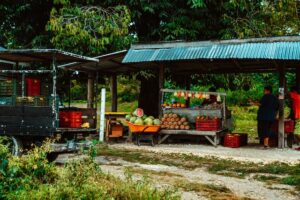Nestled within the lush rainforests of Belize lies a tiny but captivating creature, the Red-eyed Tree Frog. This iconic amphibian is renowned for its striking appearance, characterized by vibrant colors adorning its slender body and its large, bulging red eyes that seem to peer into the heart of the jungle. As one of Belize’s most beloved inhabitants, the Red-eyed Tree Frog embodies the enchanting beauty and biodiversity of this Central American paradise. Join us on a journey as we delve into the world of this fascinating amphibian, unraveling its secrets and exploring its significance in the intricate web of life in Belize’s rainforests.
A Closer Look: Discovering the Vibrant Colors of the Red-eyed Tree Frog
The Red-eyed Tree Frog’s vivid colors are like nature’s artwork, a masterpiece that blends seamlessly with the verdant greens and earthy tones of Belize’s rainforests. Its body is a canvas of vibrant hues, ranging from vibrant shades of green to electric blues and bold yellows, adorned with intricate patterns and markings that resemble intricate brushstrokes. These colors serve more than just aesthetic purposes; they play a crucial role in the frog’s survival.
One of the most fascinating aspects of the Red-eyed Tree Frog’s coloration is its ability to change hues. This phenomenon, known as metachrosis, allows the frog to adapt to its surroundings and blend in with the foliage, providing it with camouflage against predators such as birds and snakes. When resting on a leaf during the day, the frog’s green coloration helps it merge seamlessly with the leaves, becoming nearly invisible to unsuspecting eyes.
However, it’s during the night that the Red-eyed Tree Frog truly reveals its mesmerizing beauty. As darkness descends upon the rainforest, the frog’s colors intensify, transforming into a kaleidoscope of vivid hues. Its vibrant red eyes, outlined by contrasting black rings, seem to glow in the darkness, adding an eerie yet captivating allure to this nocturnal creature.
The vibrant colors of the Red-eyed Tree Frog also serve as a form of communication. During mating season, males display their brightest colors to attract potential mates, showcasing their health and vitality through their vivid hues. Additionally, these colors can also serve as a warning to potential predators, signaling the frog’s toxicity and deterring them from making a meal out of it.
In essence, the Red-eyed Tree Frog’s vibrant colors are not just a visual spectacle; they are a testament to nature’s ingenuity and the intricate adaptations that allow this tiny amphibian to thrive in the enchanting rainforests of Belize.
Icon of the Rainforest: Understanding the Role of the Red-eyed Tree Frog in Belize’s Ecosystem
The Red-eyed Tree Frog is not just a visually stunning creature; it plays a vital role in maintaining the delicate balance of Belize’s rainforest ecosystem. As an iconic species, it serves as an indicator of the rainforest’s health and vitality, reflecting the overall well-being of its habitat.
One of the key contributions of the Red-eyed Tree Frog lies in its diet. As an insectivore, it primarily feeds on a variety of insects such as crickets, moths, and beetles. By controlling insect populations, especially those that can become pests, the frog helps maintain the ecological equilibrium within the rainforest. This natural pest control reduces the need for chemical pesticides, benefiting both the ecosystem and human interests.
Furthermore, the Red-eyed Tree Frog acts as a prey species for larger predators in the rainforest food chain. Snakes, birds, and mammals rely on these frogs as a food source, forming essential links in the intricate web of predator-prey relationships. The presence of healthy populations of Red-eyed Tree Frogs indicates a thriving ecosystem with sufficient food resources for higher trophic levels.
Beyond its ecological contributions, the Red-eyed Tree Frog also plays a cultural and educational role in Belize. It has become a symbol of the country’s rich biodiversity, captivating visitors and locals alike with its beauty and charm. Educational programs and eco-tourism initiatives often feature the Red-eyed Tree Frog, raising awareness about conservation and the importance of preserving Belize’s natural heritage.
Moreover, studying the behavior and habitat preferences of the Red-eyed Tree Frog provides valuable insights into rainforest ecology and biodiversity conservation. Researchers and conservationists use data collected from these frogs to assess the health of ecosystems, identify environmental threats, and develop conservation strategies aimed at protecting not just the frog species but the entire rainforest ecosystem.
In essence, the Red-eyed Tree Frog is more than just a stunning amphibian; it is a symbol of Belize’s ecological richness and a guardian of its precious rainforest habitats.
Captivating Creatures: Unveiling the Mysteries Behind the Red-eyed Tree Frog’s Bulging Red Eyes
The Red-eyed Tree Frog’s most iconic feature is undoubtedly its striking red eyes, which stand out like jewels against its vibrant body. These bulging orbs hold more than just aesthetic appeal; they are key to understanding the frog’s behavior, adaptations, and survival strategies in the dense rainforests of Belize.
The prominent red eyes serve multiple functions, one of which is predator deterrence. When threatened, the Red-eyed Tree Frog opens its eyes wide, revealing the intense red coloration. This sudden display startles predators, giving the frog a chance to escape. The contrast between the red eyes and the frog’s green or blue body creates a bold warning signal that predators learn to associate with potential danger or unpalatability.
Interestingly, the red eyes also play a role in thermoregulation. The blood vessels near the surface of the eyes allow for efficient heat exchange, helping the frog regulate its body temperature in the tropical climate of Belize. By adjusting blood flow to the eyes, the frog can dissipate excess heat or conserve warmth as needed, contributing to its overall physiological resilience.
Moreover, the red eyes of the Red-eyed Tree Frog are crucial in communication and social interactions. During mating season, males use their vibrant eye coloration to attract females and establish dominance over rivals. The intensity of the red coloration can signal the male’s health, vigor, and genetic fitness, influencing mate selection and reproductive success.
Beyond their functional roles, the Red-eyed Tree Frog’s red eyes hold a certain mystique and allure, capturing the imagination of nature enthusiasts and photographers. Their unique appearance has made them popular subjects in wildlife documentaries, scientific studies, and nature-inspired art, further highlighting their significance as captivating creatures in Belize’s biodiversity.
In essence, the bulging red eyes of the Red-eyed Tree Frog are not just a visual spectacle; they are a testament to the frog’s evolutionary adaptations, survival strategies, and role in the intricate web of life in Belize’s enchanting rainforests.
Final Thoughts
The Red-eyed Tree Frog, with its vibrant colors, bulging red eyes, and fascinating adaptations, stands as a symbol of Belize’s rich biodiversity and the wonders of its rainforest ecosystems. Beyond its aesthetic appeal, this iconic amphibian plays crucial roles in maintaining ecological balance, serving as an indicator of environmental health, and contributing to cultural and educational initiatives.
As we unravel the mysteries behind the Red-eyed Tree Frog’s striking features, from its color-changing abilities to its predator-deterrent eyes, we gain a deeper appreciation for the complexity and resilience of nature. The frog’s role in natural pest control, thermoregulation, and communication underscores its importance in the intricate web of life in Belize’s rainforests.
Moreover, the Red-eyed Tree Frog serves as a reminder of the interconnectedness of all living beings and the delicate harmony that sustains our planet. Its presence in Belize’s ecosystems reflects the need for conservation efforts to protect not just this species but the entire biodiversity of these precious habitats.
In the realm of culture and education, the Red-eyed Tree Frog inspires awe and curiosity, sparking conversations about conservation, ecology, and the wonders of nature. Its inclusion in eco-tourism activities and educational programs fosters a deeper connection between people and the natural world, fostering a sense of stewardship and responsibility towards preserving Belize’s natural heritage.
As we conclude our exploration of this captivating creature, let us carry forward the lessons learned from the Red-eyed Tree Frog – resilience in the face of challenges, adaptability in changing environments, and the beauty of diversity in nature. May the Red-eyed Tree Frog continue to enchant and inspire generations to come, reminding us of the preciousness of our planet’s biodiversity and the need to protect it for the future.




